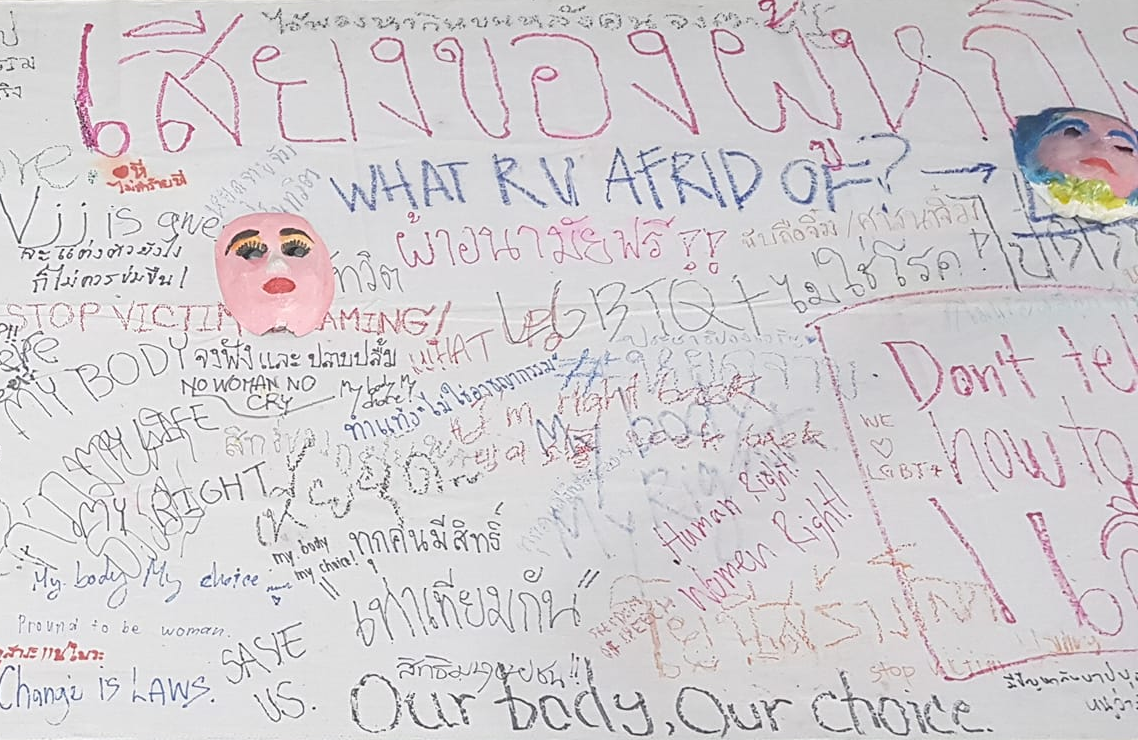
Written by Worakamon Ongvanich
Translated by Anusara Drahmoune
For over a decade, the Tam Tang group has been advocating for safe abortion access in Thailand. Tam Tang translates to ‘forging a path’; the name plays on its near homophone tham thaeng ‘to have an abortion.’ Their activism was spurred by a harrowing discovery in 2010: two thousand illegally aborted fetuses were found on the grounds of the Phai Ngoen Temple, underscoring the country’s pressing need for legal and safe abortion services. The group pushes for legislative changes and organizes a range of activities, including the annual observance of the International Safe Abortion Day on September 28. They also offer consultations for individuals seeking safe abortion services, and collaborate closely with women’s rights groups both in Thailand and internationally.
Despite the moral and cultural sensitivities around the topic in Thailand, Tam Tang has consistently disseminated information about safe abortions. While today, abortions are legally permitted under specific conditions regardless of gestational age, the group continues its advocacy for unrestricted access to abortion services, aiming to eliminate any associated prejudice or stigma.
On April 2, 2023, the Museum of Popular History hosted a seminar titled “Resist for Better Way of Life.” The event saw participation from representatives of Tam Tang and members from labor unions. Speaking at the event, ‘Tukta,’ a member of Tam Tang, underscored the significance of abortion access in enhancing people’s quality of life. After the seminar, museum staff conducted additional interviews with the Tam Tang team, delving into the evolution and specific challenges of the abortion movement, topics distinct from the main seminar discussion.
Tukta: A counselor responsible for consultations on birth control, pregnancy testing, ultrasound services, abortion locations, doctor coordination, and post-abortion mental health.
Num: An advocacy member monitoring social issues, finding opportunities to communicate abortion topics to the society, and handling communication materials such as articles.
Chompoo: Founder and coordinator, overseeing organizational activities, fundraising, overall workflow management, and handling complex cases from the counseling side such as those involving minors or violence.
Niab: The organizational manager in charge of overseeing main organizational activities, tracking progress across divisions, ensuring successful project completions, and liaising with external organizations and individuals like journalists.
Furthermore, there are other members in the Tam Tang group, including campaigners, counselors, and organizational communicators, who didn’t participate in this particular seminar’s interviews.

Because the Body Itself Is Political.
Our conversation began with the topic of the human right to protect one’s body—a fundamentally political issue. The Tam Tang group contends that this is about power, of which everyone must be cognizant. The right to bodily autonomy is as crucial as making demands to Thailand’s dictatorship or pushing for legislative amendments. Moreover, this claim to autonomy over one’s body isn’t exclusive to the women’s rights movement.
Though the issue of abortion ties to the right to bodily autonomy, Tam Tang emphasized that, in practical terms, deciding to have an abortion encompasses a spectrum of parties. This ranges from familial dynamics—where the pregnant person might lack decision-making rights—to the power balance between doctors and patients. For instance, a physician may decline to perform the procedure even when a patient has explicitly expressed their desire for an abortion. Yet, because not all feel the direct impact—or possess the courage to voice how the matter impacts them personally—many continue to view it as a private concern, separate from the political arena.
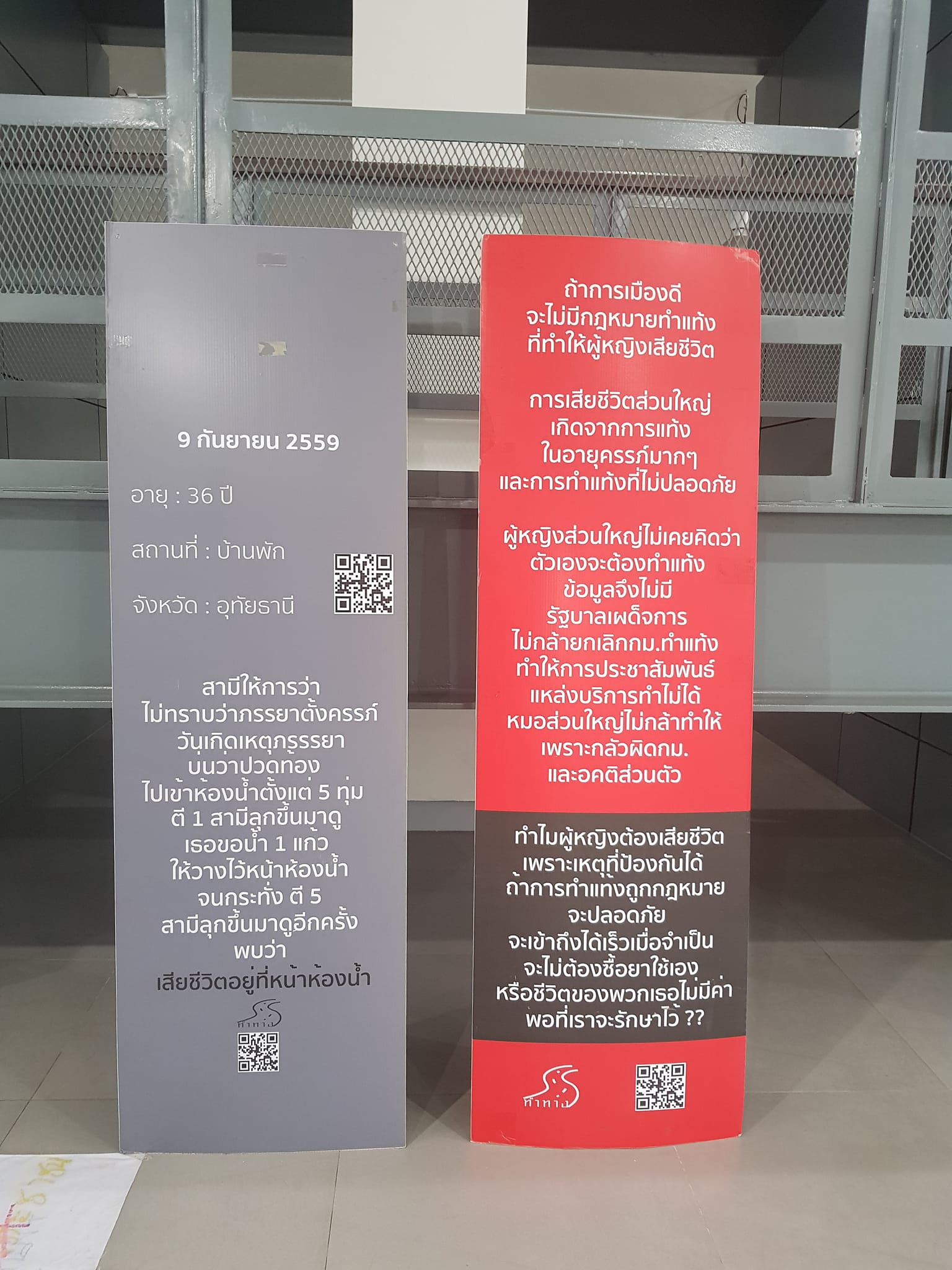
Law at the Forefront of Abortion Politics
Niab and Chompoo referenced legal updates highlighting that amendments to abortion laws were made at the end of 2020, taking effect in 2021. The revised legislation allows the termination of pregnancies up to 12 weeks without the need to cite specific reasons. Furthermore, if the pregnancy is under 20 weeks, an abortion is allowed after requisite counseling. The law continues to allow abortions without any gestational age restrictions in cases of medical necessity or rape. Before these changes, abortions were only allowed under three conditions: instances of rape, when the pregnancy posed threats to the woman’s mental or physical well-being, or in cases of fetal abnormalities.
Even with the legal revisions, hurdles persist for those unprepared to proceed with their pregnancies. Though the law now allows for it, numerous medical professionals in general hospitals continue to decline offering the procedure, rooted in the belief that abortion equates to “taking a child’s life.”
Chompoo provided additional insight, explaining that for pregnancies in their early stages, around 6-7 weeks, the use of abortion pills can lead to pain resembling menstrual cramps. This method induces the body to expel the minuscule embryo, mimicking the processes of childbirth. The embryo at this stage may be so tiny that it’s only discernible under a microscope. Despite this, certain doctors remain hesitant to prescribe these pills, citing concerns about committing a sin or affecting the spirit of the unborn child. For pregnancies that have advanced beyond 12 weeks, where the fetus begins to assume a distinguishable shape, securing abortion services becomes even more challenging. As the public receives little information about these issues, the process of finding abortion services is slowed down, which complicates the ability of individuals to make well-informed decisions.
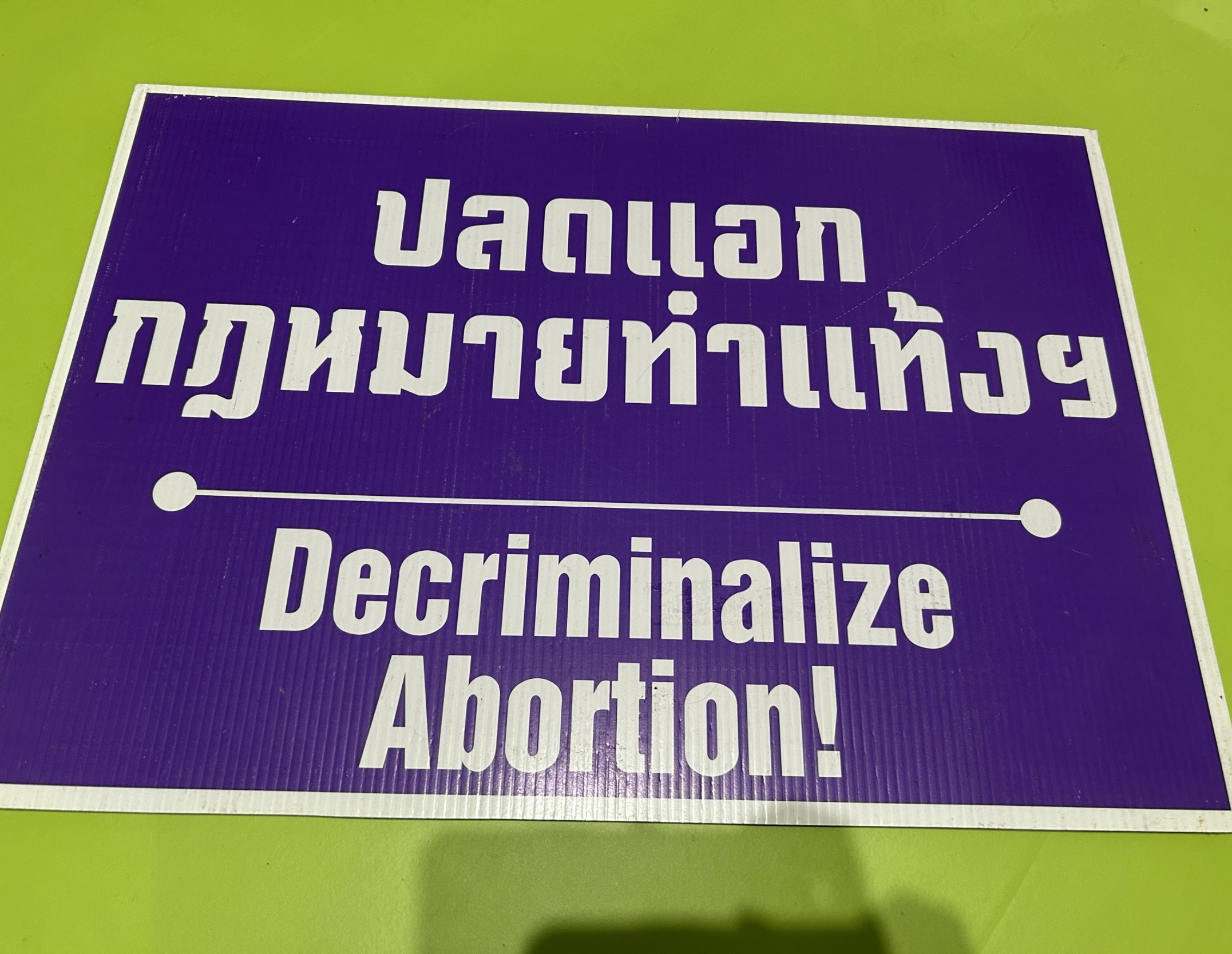
Abortion Risks: Myths over Science
In addressing the question, “Is abortion tantamount to taking a child’s life?”, Tam Tang emphasized that, scientifically speaking, a fetus cannot maintain a life autonomously from the mother in its early stages, nor does it possess fully developed organs or a nervous system capable of sensing pain, thus it isn’t classified as ‘alive.’ Furthermore, referencing international human rights norms, the “right to life” is conferred upon an individual post-birth; there is no such thing as fetus rights.
Tam Tang contends that the prerogative to decide on abortion or continuing with a pregnancy should reside with the individual bearing the child. However, in real-world scenarios, the choice is frequently made for the individual by others. Present-day Thai regulations dictate that only licensed medical professionals have the authority to prescribe abortion pills. This raises concerns within the medical community, as many practitioners’ patriarchal mindset influences their professional judgments, resulting in numerous individuals being denied essential services.
Tukta, who had personally gone through an abortion, expressed, “We are heavily oppressed. Our bodies are subjected to the decisions of others, requiring the authority of those more knowledgeable to decide for us. That’s why we have to argue that our experiences also count as knowledge. We believe that some doctors deny abortions not based on professional ethics but rather on personal moral grounds. These two should be different things. Such morality aims to save lives, but it often focuses more on the fetus inside the womb, ignoring the importance of the life of the pregnant individual. In many countries, pregnant individuals are allowed to die because doctors don’t dare to perform abortions, prioritizing the life of the fetus. They are so focused on ‘saving lives’ that they neglect the rights of the person who still has a life to live.”
Tukta also highlighted that in various countries, there are instances where medical professionals decline to offer abortion services even when the individual’s health is in jeopardy and they are unprepared for a child, as seen in situations of toxic pregnancies or serious fetal abnormalities. This denial forces many to turn to perilous means of ending their pregnancies involving self-administered drugs or self-inflicted procedures, which can lead to fatal infections and other complications. This underscores the fact that denying access to safe abortion services doesn’t prevent abortions; rather, it drives individuals towards riskier abortion methods, effectively encouraging them.
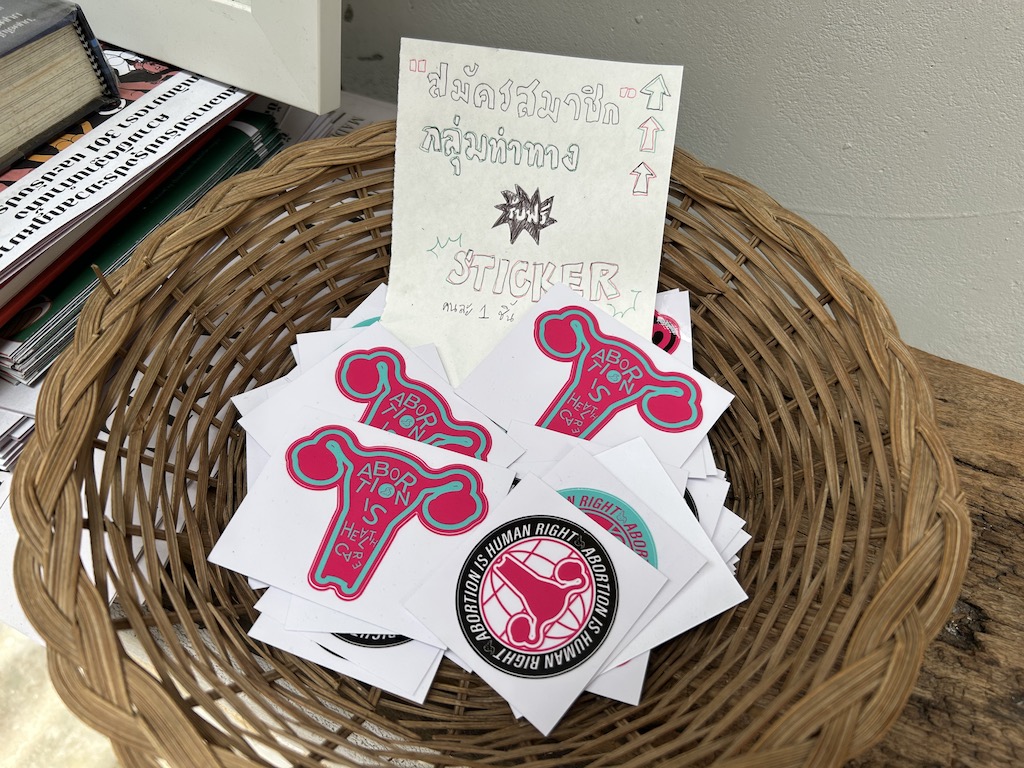
Unprepared for Motherhood: The Case for Abortion Options
Tam Tang’s analysis, based on data from one Bangkok hospital, indicates that out of 14 individuals who sought abortion services, only one proceeded with the termination, while the other 13 chose to carry on with their pregnancies. The group speculates that these figures might demonstrate the sway medical personnel hold in nudging these individuals to reconsider their choices. This suspicion is bolstered by a prior incident where a doctor openly shared a similar account on their personal Facebook page, insinuating they “guided” someone towards the delights of motherhood.
Tukta stated, “In reality, pregnancy is a gamble – wondering if one will find happiness in motherhood after childbirth. Many mothers suffer from postpartum depression, an aversion to caring for their child, or even harboring thoughts of harming their child. The reasons aren’t limited to hormonal changes but also encompass the responsibilities of childcare. Motherhood isn’t easy. Mothers are expected to feed their child every three hours, a demanding task likened to the body being transformed into a baby food factory. The stress intensifies if there’s insufficient breast milk, leading to fears about the child’s nutrition. With a challenging economic landscape and the high cost of formula, if a child is allergic, the blame often falls on the mother for not providing breast milk. Many mothers end up blaming themselves for not being strong enough to provide for their child.”
Speaking about the physical changes after pregnancy, Tukta explained, “After giving birth, the belly doesn’t immediately go back to its previous state. The body doesn’t return to its usual form right away. Genitalia may not appear as one remembered, and the nipples change. Many mothers must be ready to embrace these changes when they have a child. These changes naturally happen to those who are prepared and willingly go through them because it’s challenging. Thus, opposing abortion on moral grounds doesn’t take into consideration who becomes a mother and why they should. We believe that it’s unjust for society to solely place the burden on pregnant women, making them responsible for both their own lives and their child’s.”
The Tam Tang group highlighted examples of many who, post-abortion, led fulfilling lives. Such outcomes included completing their education, breaking free from poverty, evading subordinate relationship roles, and preventing single motherhood, among others.
Tukta added, “If forced down that path, I would not have made it out alive. In some cases, an unplanned pregnancy can lead to being ostracized from the family. There’s a prevailing attitude that having a daughter is like having a toilet in front of one’s house. If the daughter becomes pregnant out of wedlock or without a known father, it’s as if the toilet has overflowed, creating a major scandal for the family. So, I can say with conviction that abortion took my life to a better place.”
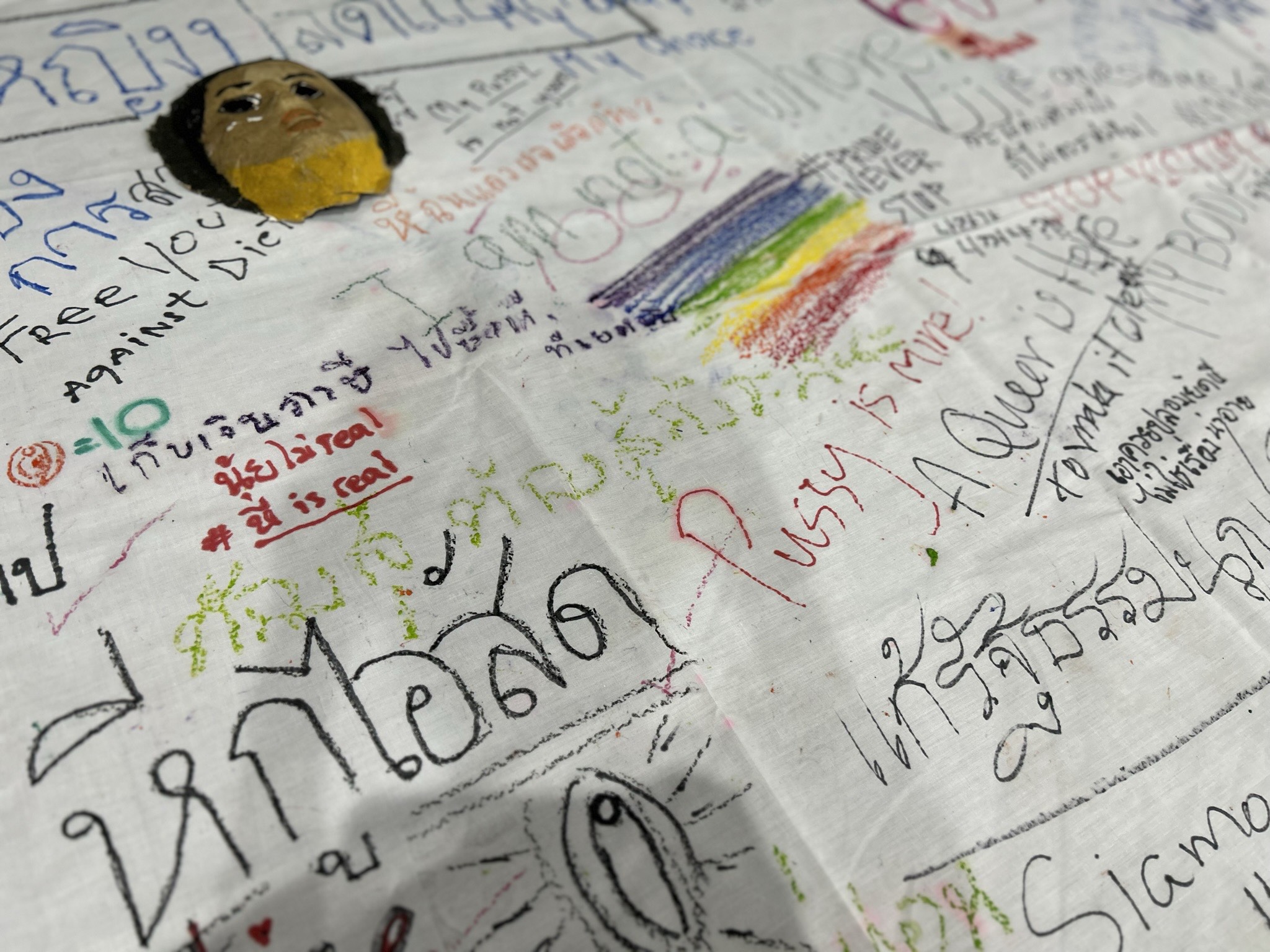
A Message for Medical Policy Makers
After recent legal revisions, Tam Tang reached out to medical professionals to emphasize that abortion is a medical treatment, akin to surgery or dental procedures. They argued that if a medical professional is unable to provide the service, they should promptly refer the patient to another facility.
The group also advises doctors to be aware of the rights of their patients and their own professional ethics. Physicians should not unduly influence patients towards any particular decision and should not limit the choices of those unprepared for pregnancy. Doctors are encouraged to follow standard professional procedures like preliminary examinations, answering questions, offering counseling, and quickly referring patients if they cannot provide the needed service themselves.
Tam Tang also believes that there shouldn’t be laws criminalizing abortion, since, in similar circumstances, childbirth isn’t criminalized. Instead, there are regulations ensuring doctors adhere to certain standards to ensure quality service. Similarly, the focus for abortion should be on access to safe and quality care rather than creating specific laws for it.
Tukta noted that in certain hospitals, nurses or social workers often encourage patients to re-evaluate their life decisions. While this guidance might benefit those ready for parenthood, leveraging maternal instincts to sway those unprepared for a child can pose issues. This approach seems to gloss over the reality that having children isn’t always a clear-cut path to happiness. Parenting brings enduring challenges and can be more burdensome than beneficial for those unprepared.
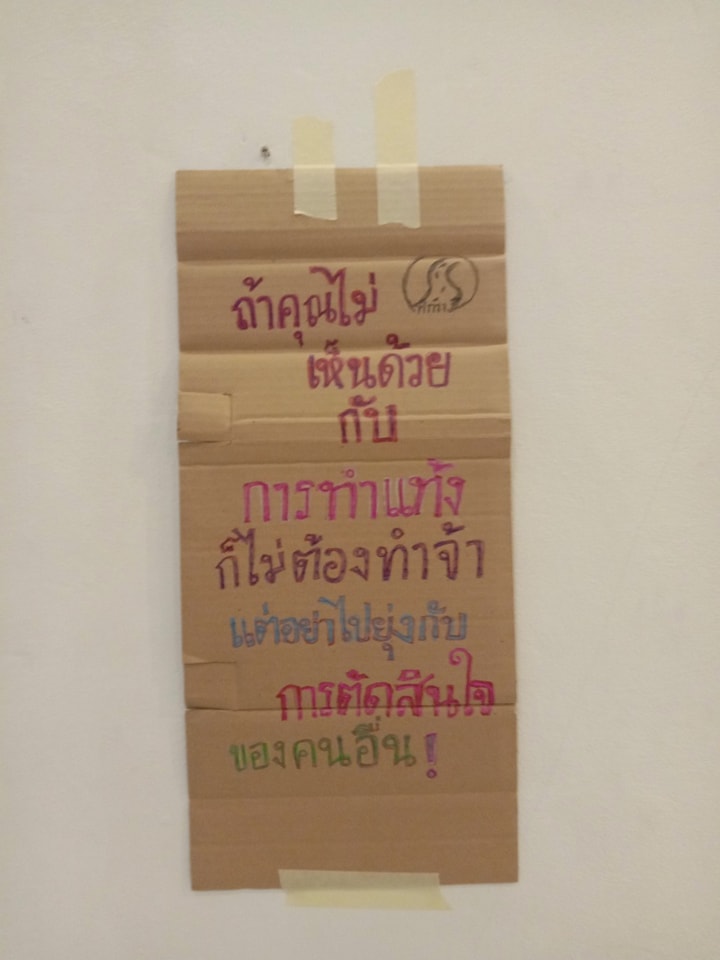
Abortion Narratives: The Many Facets of Women’s Experiences
In a recent exhibition highlighting resistance to prevalent viewpoints, the Tam Tang group showcased a white shirt imprinted with pink letters that read, “Abortion: Other Sides to Women’s Stories.” Chompoo explained that this shirt campaign took place around 2012-2013. It was an initiative where women who had undergone abortions took photos of themselves with symbols from their countries and then compiled these images as a global campaign. Notable Thai organizations, including Rong Nam Cha (Tea House) and the Bangkok Art and Culture Centre (BACC), supported the campaign. The shirt was created to emphasize that women’s experiences and reasons are diverse and multifaceted. One of these reasons is the choice of some women not to become mothers. Interestingly, the shirt featured Thai language on the front and another language on the back. This was a strategic move, as there were concerns that some local Thai onlookers might feel uncomfortable if they read the message. Chompoo further noted that a decade ago, abortion was largely seen as morally wrong in Thailand. On several occasions when she wore this shirt out, Thai people who passed by would point and start whispering among themselves.
Tukta added, “I really appreciate the phrase ‘There are many sides to women’s stories’ because it suggests that the issue of abortion isn’t just about the narrow perspective most people are familiar with. There are numerous reasons why women choose to have abortions, like their rights, and it’s not just about morality. Sometimes, criticism towards women who have had abortions arises simply because society lacks understanding about the procedure.”
Apart from the aforementioned campaign, another significant shirt design was displaying the hashtag #weToo. The shirt featured an illustration of shirtless women hugging each other, with some painted with the crossed-out number 301 and the word “abortion.” (Article 301 of the Thai Criminal Code sets the punishment for certain abortions.) Additionally, the phrase “weLoveYou” was prominently displayed, indicating the solidarity and understanding among women who have undergone abortions, emphasizing that they are not alone.
This shirt was particularly significant during the period when advocates were pushing for a revision of the abortion laws in 2019. The move was partly spurred by a controversial incident in 2018 when Dr. Srisamai Chueachart faced legal proceedings for performing abortion services. The case gained notoriety when a fetus was discovered in the trash, and the media reported it in a sensationalist manner, dubbing it “The Hua Hin City Abortion.” The RSA (Referral System for Safe Abortion) network, which is a coalition of medical professionals offering abortion services in Thailand, together with the Choices Network and the Tam Tang group, mobilized to defend and support medical professionals providing these services.
The advocacy group also introduced a campaign sign that reads: “If you don’t agree with abortion, don’t have one. But don’t interfere with others’ decisions!” Niab recounted that this message was inspired by abortion campaign slogans from the United States, which convey a straightforward stance on the right to abortion being the prerogative of the pregnant individual. When this slogan was shared on platforms like Twitter and Facebook, it gained significant traction, leading to widespread dissemination and further use in advocating for abortion rights.
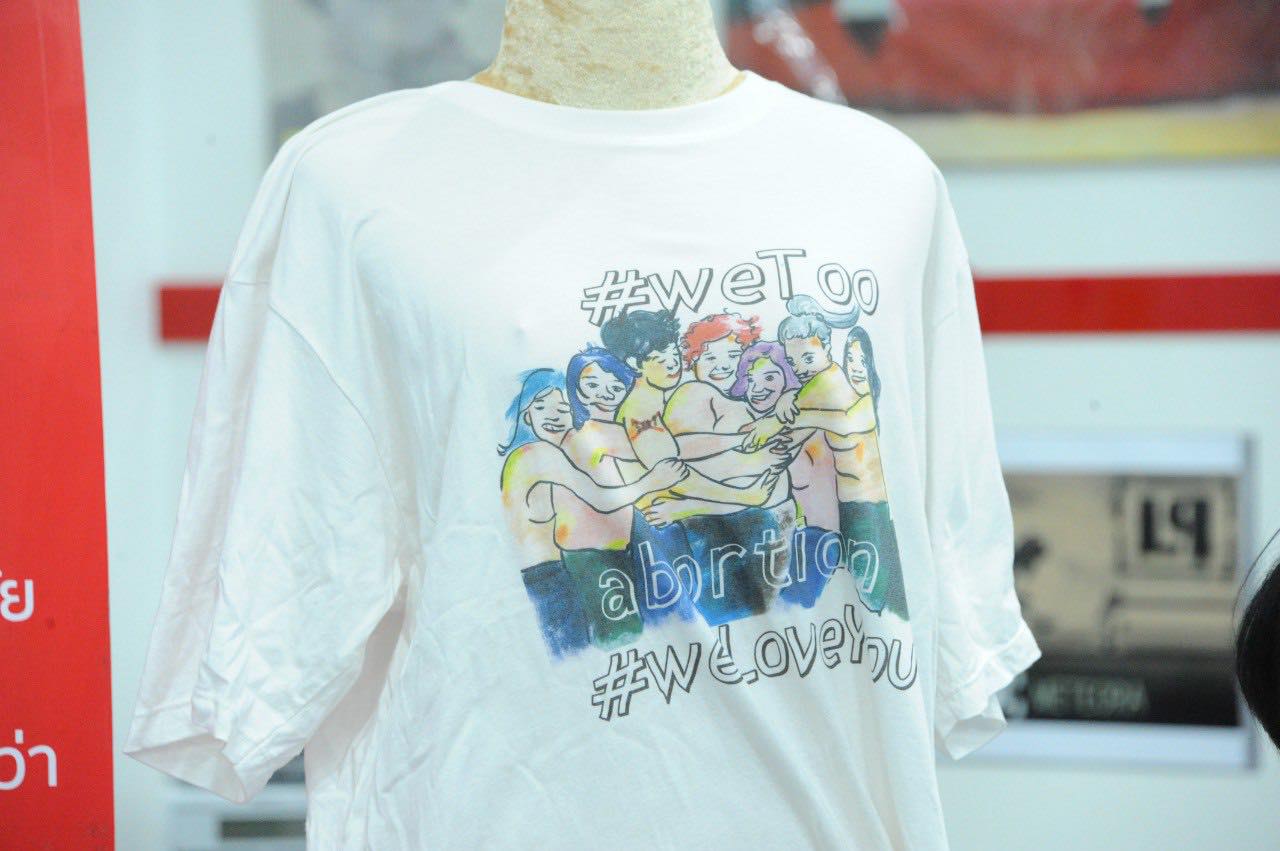
“Baby Ghosts”: An Abortion Trope
Another campaign by Tam Tang was the curation of a fabric banner featuring the “Baby Ghost,” as part of the exhibition titled “Spirits of the Marginalized” The concept for this display originated from exploring the imagery of the “Baby Ghost” in stories and interpretations from those who have had abortions. This seeks to pose questions to society: Why has abortion become a haunting memory, evoking fear? What causes those who undergo abortions to be condemned or associated with spirits? It further underscores societal judgements levied against individuals who are pregnant but not prepared to embrace motherhood. The exhibition was held from August 8 to August 22, 2023.
In this exhibition, a notable character is “Ice,” the girl ghost from the film The Swimmers. Ice is portrayed as a young teenager who became pregnant prematurely and tragically died from an unsafe abortion. She transforms into a tormented spirit, haunting the same location, overwhelmed with pain and vengefulness. This haunting serves as a reflection of societal memories: from teenage pregnancies and inadequate state welfare for legal abortion procedures to the ingrained notion that pregnant individuals should naturally embrace motherhood upon discovering they’re carrying a fetus.
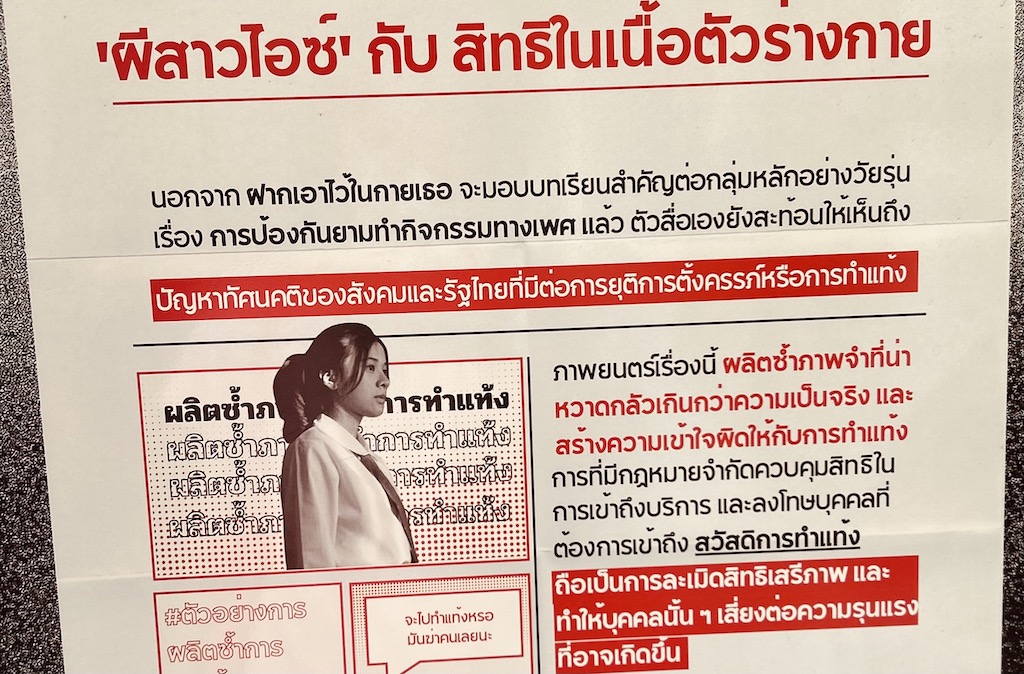
Adjacent to this display, a large white banner labeled “Baby Ghost” can be found. This addresses the societal perception that aborting a fetus equates to killing a baby. In reality, a fetus isn’t yet considered a human. However, contemporary society often attributes guilt, legal and moral, to those who choose abortion. They are stigmatized as “heartless mothers” or “child murderers,” even pressuring medical professionals who support abortion rights. Often, media, including dramas and movies, depict vengeful spirits of aborted fetuses chasing after those who chose abortion, represented through eerie laughter, crying sounds, or images of small children. The Tam Tang group aims to highlight this as societal punishment and a misrepresentation of motherhood. Medically, a two-month-old fetus is merely two-to-three centimeters in size. The banner further delves into varied narratives about the “baby ghosts” from the perspective of those who had abortions. These narratives range from beliefs that the fetus might be reborn as a pet cat, to feelings that it was a family member, to hopes of reuniting in another lifetime, to some who don’t believe in the existence of such spirits at all.
Regardless of whether these “baby ghosts” are real or what their appearances might be, the exhibition suggests that interpretations should be left to those who’ve experienced these situations, allowing them to define their own stories.
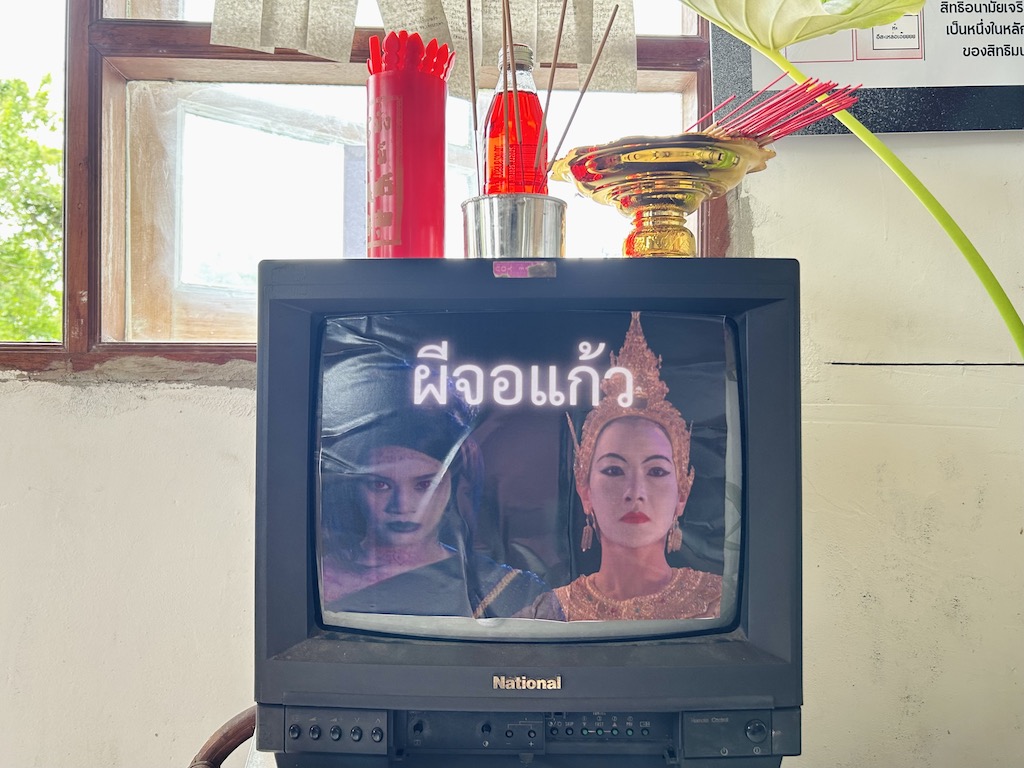
The Online Movement of Tam Tang
Tam Tang has been consistently championing their cause online. Recently, the group has intensified its operations through the social media platform Twitter, receiving positive feedback for its efforts.
Chompoo explained that Twitter is currently their most effective platform. “Twitter users are primarily of the younger generation who are more inclined to understand our issues. Twitter provides a space for discussions on sexuality, including experiences of sexual harassment, abortion, gender diversity, HIV-related topics, and issues concerning sex workers. People are constantly speaking up about these issues. There’s an increasing call for gender rights every year, and discussions around sexuality on social media have become very normalized. This is mainly because contemporary platforms provide more opportunities for people to voice their opinions, which has led to heightened interest in these topics.”
In addition to providing consultation on safe abortions, Tam Tang also offers advice on birth control and disseminates knowledge about women’s rights. You can follow them for more information on Twitter @TamtangTH, on the Facebook Pages “Talking to Women Who Have Abortions” or “Tamtang Group,” and on https://womenhelp.org/th/page/437/thailand-tamtang-group
This article is co-produced by the Museum of Popular History and the Siddhi-Issara Foundation as part of the project Dissident Dreams, sponsored by Democracy Discourse Series, De La Salle University, the Philippines
